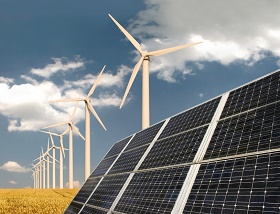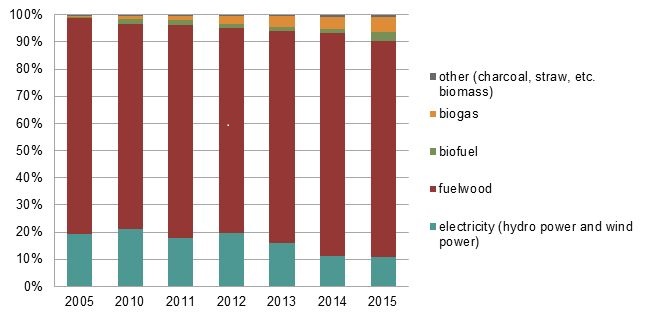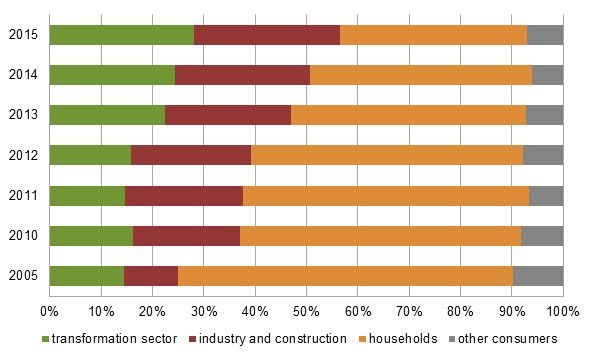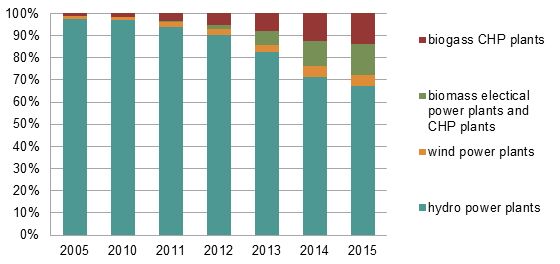Analytics, Energy, Energy Market, EU – Baltic States, Innovations, Latvia, Statistics
International Internet Magazine. Baltic States news & analytics
Wednesday, 24.04.2024, 17:07
Latvia has the second highest share of renewable sources in the energy consumption in the EU
 Print version
Print version |
|---|
Notable
increase was recorded in consumption of biofuel (bioethanol, biodiesel) – 19.9
times during the decade, and by 213% compared to 2014. During the last decade,
consumption of biogas (landfill gas, sewage sludge gas, other biogas) has risen
10.8 times and, compared to 2014, by 17%.
Consumption of renewable energy resources in Latvia, PJ

Over the decade, gross
consumption of fuelwood has increased by 6.4%, reaching 52.6 PJ in 2015,
whereas compared to 2014 the indicator has reduced by 6.0%. In 2015, the share
of fuelwood in the gross energy consumption accounted for 28.4% – 1.6 p. p. less
than in 2014. In 2015, Latvia exported 33.7 PJ of fuelwood – 11.1% more than in
2014. Compared to 2014, the volume of wood pellets produced grew by 14.1%, and
the volume of wood chips produced went up by 8.4%. In 2015, Latvia exported
28.0 PJ of wood pellets – 20.4% more than in 2014.
The highest consumption of fuelwood still was recorded in
household sector, however the indicator has declined by 28.7% during the
decade, constituting 36.4% of the gross consumption of fuelwood in 2015.
Compared to 2005, fuelwood consumed in industry and construction has risen 2.9
times, and in 2015 fuelwood consumption in the sectors accounted for 28.5% of
the gross consumption of fuelwood.
During the decade, the share of
renewable resources consumed in transformation sector has grown by 19.4 percentage
points, reaching 36.1% in 2015. Compared to 2014, the consumption of fuelwood
in transformation sector has went up by 7.6%. It may be explained by the fact
that number of combined heat and power (CHP) plants and share of renewable
sources in the transformation sector was growing, and the share of natural gas
was reducing. During the time period from 2005 to 2015, consumption of fuelfood
in the transformation sector increased 2.1 times, reaching 14.7 PJ last year.
Consumption of fuelwood in Latvia, %

Since 2010, installed electrical capacity of CHP plants using
renewable resources rose 7.9, and in 2015 it comprised 126 MW – 5 MW more
than in 2014. The volume of electricity produced in CHP plants using renewable
resources has grown 11.6 times since 2010, reaching 765 GWh – 96 GWh more than
in 2014. In 2015, 2 772 GWh of electricity were produced from the renewable
resources, and, compared to 2014, the indicator almost has not changed (-1.1%).
During the decade, the volume of electricity produced in wind power plants has
increased from 47 to 147 GWh, the volume produced in biomass (firewood, wood
waste) electrical power plants and CHP plants has risen from 6 to 378 GWh, and
the volume produced in biogas CHP plants – from 36 to 387 GWh.
Electricity produced from renewable energy resources, %

During the recent years,
installed electrical capacity of hydro power plants has not changed
significantly, whereas the indicator in wind power plants and CHP plants using
renewable resources has increased notably. During the last five years,
installed electrical capacity of wind power plants rose 2.3 times, reaching 69
MW in 2015. Compared to 2014, in 2015 electrical capacity of biogas CHP plants
grew by 4.8% and of biomass power plants and CHP power plants – by 3.4% (5.5
times, compared to 2010). One of the reasons behind the increase in consumption
of renewable sources in electricity production is the state support allowing to
sell electricity within the framework of mandatory procurement.
Directive 2009/28/EC of the European Parliament and of the
Council on promotion of the use of energy from renewable sources stipulated
that the share of renewable sources in gross energy consumption in 2020 should
comprise 40%. Latvia has the second highest share of renewable sources in the
energy consumption in the European Union; in 2014 Latvian indicator constituted
38.7 % (EU average – 16.0 %). Moreover, each Member State in 2020 should ensure
that the share of energy from renewable sources (biofuel, biogas, electricity
produced from renewable sources and consumed in transport) comprises at least
10 % of the final energy consumption in transport (in 2014 Latvia reached
3.23 %).








 «The Baltic Course» Is Sold and Stays in Business!
«The Baltic Course» Is Sold and Stays in Business!

